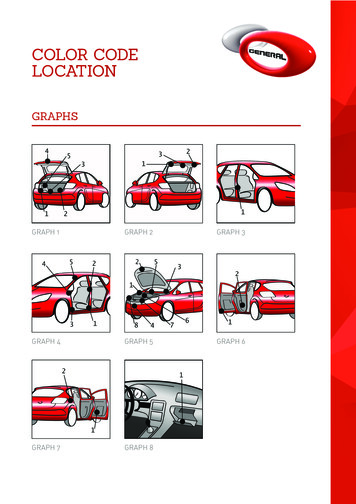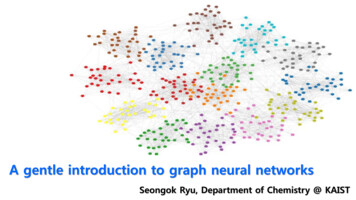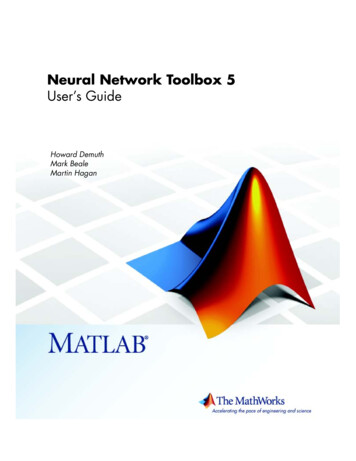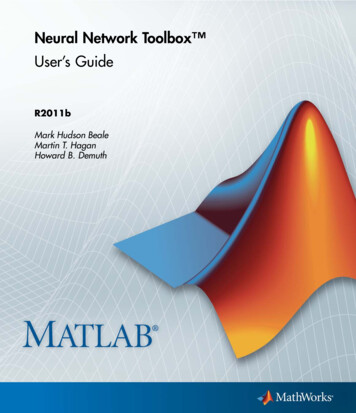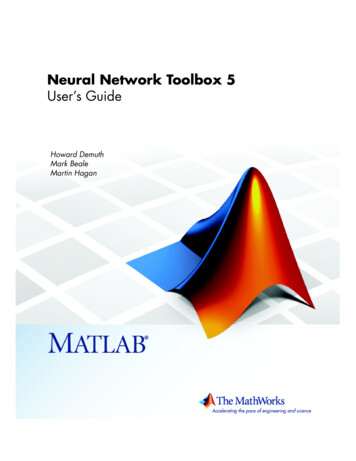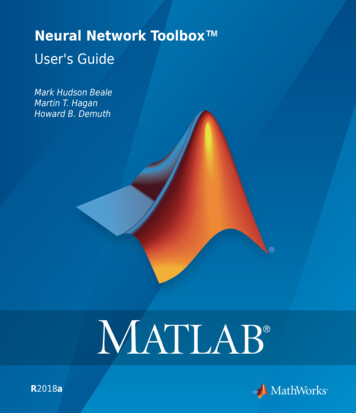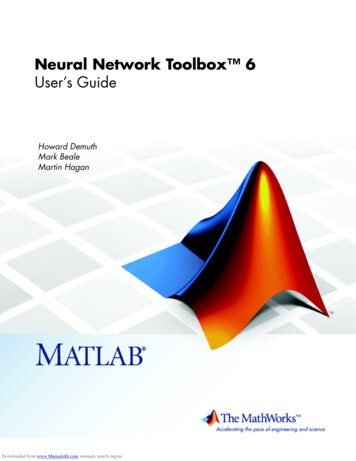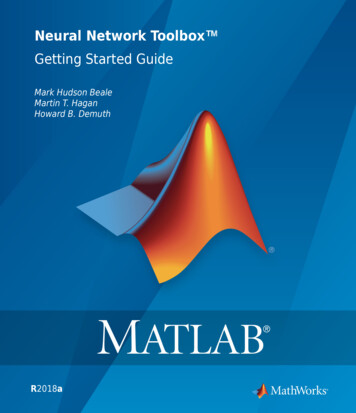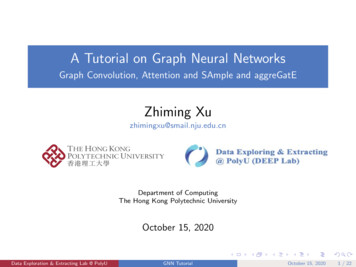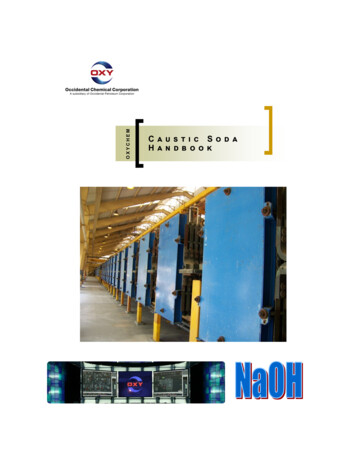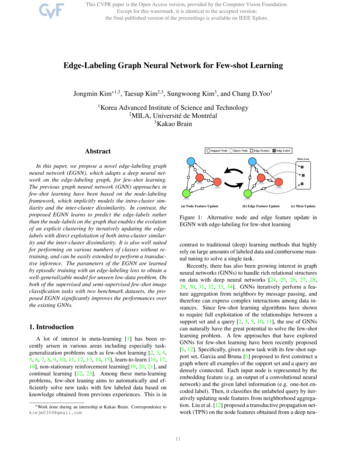
Transcription
Edge-Labeling Graph Neural Network for Few-shot LearningJongmin Kim 1,3 , Taesup Kim2,3 , Sungwoong Kim3 , and Chang D.Yoo11Korea Advanced Institute of Science and Technology2MILA, Université de Montréal3Kakao BrainAbstractIn this paper, we propose a novel edge-labeling graphneural network (EGNN), which adapts a deep neural network on the edge-labeling graph, for few-shot learning.The previous graph neural network (GNN) approaches infew-shot learning have been based on the node-labelingframework, which implicitly models the intra-cluster similarity and the inter-cluster dissimilarity. In contrast, theproposed EGNN learns to predict the edge-labels ratherthan the node-labels on the graph that enables the evolutionof an explicit clustering by iteratively updating the edgelabels with direct exploitation of both intra-cluster similarity and the inter-cluster dissimilarity. It is also well suitedfor performing on various numbers of classes without retraining, and can be easily extended to perform a transductive inference. The parameters of the EGNN are learnedby episodic training with an edge-labeling loss to obtain awell-generalizable model for unseen low-data problem. Onboth of the supervised and semi-supervised few-shot imageclassification tasks with two benchmark datasets, the proposed EGNN significantly improves the performances overthe existing GNNs.1. IntroductionA lot of interest in meta-learning [1] has been recently arisen in various areas including especially taskgeneralization problems such as few-shot learning [2, 3, 4,5, 6, 7, 8, 9, 10, 11, 12, 13, 14, 15], learn-to-learn [16, 17,18], non-stationary reinforcement learning[19, 20, 21], andcontinual learning [22, 23]. Among these meta-learningproblems, few-shot leaning aims to automatically and efficiently solve new tasks with few labeled data based onknowledge obtained from previous experiences. This is in Work done during an internship at Kakao Brain. Correspondence tokimjm0309@gmail.comFigure 1: Alternative node and edge feature update inEGNN with edge-labeling for few-shot learningcontrast to traditional (deep) learning methods that highlyrely on large amounts of labeled data and cumbersome manual tuning to solve a single task.Recently, there has also been growing interest in graphneural networks (GNNs) to handle rich relational structureson data with deep neural networks [24, 25, 26, 27, 28,29, 30, 31, 32, 33, 34]. GNNs iteratively perform a feature aggregation from neighbors by message passing, andtherefore can express complex interactions among data instances. Since few-shot learning algorithms have shownto require full exploitation of the relationships between asupport set and a query [2, 3, 5, 10, 11], the use of GNNscan naturally have the great potential to solve the few-shotlearning problem. A few approaches that have exploredGNNs for few-shot learning have been recently proposed[6, 12]. Specifically, given a new task with its few-shot support set, Garcia and Bruna [6] proposed to first construct agraph where all examples of the support set and a query aredensely connected. Each input node is represented by theembedding feature (e.g. an output of a convolutional neuralnetwork) and the given label information (e.g. one-hot encoded label). Then, it classifies the unlabeled query by iteratively updating node features from neighborhood aggregation. Liu et al. [12] proposed a transductive propagation network (TPN) on the node features obtained from a deep neu-11
ral network. At test-time, it iteratively propagates one-hotencoded labels over the entire support and query instancesas a whole with a common graph parameter set. Here, itis noted that the above previous GNN approaches in fewshot learning have been mainly based on the node-labelingframework, which implicitly models the intra-cluster similarity and inter-cluster dissimilarity.On the contrary, the edge-labeling framework is able toexplicitly perform the clustering with representation learning and metric learning, and thus it is intuitively a more conducive framework for inferring a query association to an existing support clusters. Furthermore, it does not require thepre-specified number of clusters (e.g. class-cardinality orways) while the node-labeling framework has to separatelytrain the models according to each number of clusters. Theexplicit utilization of edge-labeling which indicates whetherthe associated two nodes belong to the same cluster (class)have been previously adapted in the naive (hyper) graphs forcorrelation clustering [35] and the GNNs for citation networks or dynamical systems [36, 37], but never applied toa graph for few-shot learning. Therefore, in this paper, wepropose an edge-labeling GNN (EGNN) for few-shot leaning, especially on the task of few-shot classification.The proposed EGNN consists of a number of layersin which each layer is composed of a node-update blockand an edge-update block. Specifically, across layers, theEGNN not only updates the node features but also explicitly adjusts the edge features, which reflect the edgelabels of the two connected node pairs and directly exploitboth the intra-cluster similarity and inter-cluster dissimilarity. As shown in Figure 1, after a number of alternativenode and edge feature updates, the edge-label predictioncan be obtained from the final edge feature. The edge lossis then computed to update the parameters of EGNN with awell-known meta-learning strategy, called episodic training[2, 9]. The EGNN is naturally able to perform a transductive inference to predict all test (query) samples at once as awhole, and this has shown more robust predictions in mostcases when a few labeled training samples are provided. Inaddition, the edge-labeling framework in the EGNN enablesto handle various numbers of classes without remodeling orretraining. We will show by means of experimental resultson two benchmark few-shot image classification datasetsthat the EGNN outperforms other few-shot learning algorithms including the existing GNNs in both supervised andsemi-supervised cases.Our main contributions can be summarized as follows: The EGNN is first proposed for few-shot learning withiteratively updating edge-labels with exploitation ofboth intra-cluster similarity and inter-cluster dissimilarity. It is also able to be well suited for performingon various numbers of classes without retraining. It consists of a number of layers in which each layer iscomposed of a node-update block and an edge-updateblock where the corresponding parameters are estimated under the episodic training framework. Both of the transductive and non-transductive learningor inference are investigated with the proposed EGNN. On both of the supervised and semi-supervised fewshot image classification tasks with two benchmarkdatasets, the proposed EGNN significantly improvesthe performances over the existing GNNs. Additionally, several ablation experiments show the benefitsfrom the explicit clustering as well as the separate utilization of intra-cluster similarity and inter-cluster dissimilarity.2. Related worksGraph Neural Network Graph neural networks werefirst proposed to directly process graph structured data withneural networks as of form of recurrent neural networks[28, 29]. Li et al. [31] further extended it with gated recurrent units and modern optimization techniques. Graphneural networks mainly do representation learning with aneighborhood aggregation framework that the node featuresare computed by recursively aggregating and transformingfeatures of neighboring nodes. Generalized convolutionbased propagation rules also have been directly applied tographs [34, 38, 39], and Kipf and Welling [30] especiallyapplied it to semi-supervised learning on graph-structureddata with scalability. A few approaches [6, 12] have explored GNNs for few-shot learning and are based on thenode-labeling framework.Edge-Labeling Graph Correlation clustering (CC) is agraph-partitioning algorithm [40] that infers the edge labels of the graph by simultaneously maximizing intracluster similarity and inter-cluster dissimilarity. Finley andJoachims [41] considered a framework that uses structuredsupport vector machine in CC for noun-phrase clusteringand news article clustering. Taskar [42] derived a maxmargin formulation for learning the edge scores in CC forproducing two different segmentations of a single image.Kim et al. [35] explored a higher-order CC over a hypergraph for task-specific image segmentation. The attention mechanism in a graph attention network has recentlyextended to incorporate real-valued edge features that areadaptive to both the local contents and the global layersfor modeling citation networks [36]. Kipf et al. [37] introduced a method to simultaneously infer relational structurewith interpretable edge types while learning the dynamicalmodel of an interacting system. Johnson [43] introduced theGated Graph Transformer Neural Network (GGT-NN) for12
natural language tasks, where multiple edge types and several graph transformation operations including node stateupdate, propagation and edge update are considered.Few-Shot Learning One main stream approach for fewshot image classification is based on representation learningand does prediction by using nearest-neighbor according tosimilarity between representations. The similarity can be asimple distance function such as cosine or Euclidean distance. A Siamese network [44] works in a pairwise manner using trainable weighted L1 distance. A matching network [2] further uses an attention mechanism to derive andifferentiable nearest-neighbor classifier and a prototypicalnetwork [3] extends it with defining prototypes as the meanof embedded support examples for each class. DEML [45]has introduced a concept learner to extract high-level concept by using a large-scale auxiliary labeled dataset showing that a good representation is an important component toimprove the performance of few-shot image classification.A meta-learner that learns to optimize model parametersextract some transferable knowledge between tasks to leverage in the context of few-shot learning. Meta-LSTM [8]uses LSTM as a model updater and treats the model parameters as its hidden states. This allows to learn the initialvalues of parameters and update the parameters by reading few-shot examples. MAML [4] learns only the initialvalues of parameters and simply uses SGD. It is a modelagnostic approach, applicable to both supervised and reinforcement learning tasks. Reptile [46] is similar to MAMLbut using only first-order gradients. Another generic metalearner, SNAIL [10], is with a novel combination of temporal convolutions and soft attention to learn an optimal learning strategy.3. MethodIn this section, the definition of few-shot classificationtask is introduced, and the proposed algorithm is describedin detail.3.1. Problem definition: Few-shot classificationThe few-shot classification aims to learn a classifierwhen only a few training samples per each class are given.Therefore, each few-shot classification task T contains asupport set S, a labeled set of input-label pairs, and a queryset Q, an unlabeled set on which the learned classifier isevaluated. If the support set S contains K labeled samplesfor each of N unique classes, the problem is called N -wayK-shot classification problem.Recently, meta-learning has become a standard methodology to tackle few-shot classification. In principle, we cantrain a classifier to assign a class label to each query sample with only the compact support set of the task. However, a small number of labeled support samples for eachtask are not sufficient to train a model fully reflecting theinter- and intra-class variations, which often leads to unsatisfactory classification performance. Meta-learning onexplicit training set resolves this issue by extracting transferable knowledge that allows us to perform better few-shotlearning on the support set, and thus classify the query setmore successfully.As an efficient way of meta-learning, we adopt episodictraining [2, 9] which is commonly employed in various literatures [3, 4, 5]. Given a relatively large labeled trainingdataset, the idea of episodic training is to sample trainingtasks (episodes) that mimic the few-shot learning setting oftest tasks. Here, since the distribution of training tasks is assumed to be similar to that of test tasks, the performances ofthe test tasks can be improved by learning a model to workwell on the training tasks.More concretely, in episodic training, both training andtest tasks of the NS-way K-shot problem are formed asN Kfollows: T S Q where S {(xi , yi )}i 1andN K TQ {(xi , yi )}i N K 1 . Here, T is the number of querysamples, and xi and yi {C1 , · · · CN } CT C are theith input data and its label, respectively. C is the set of allclasses of either training or test dataset. Although both thetraining and test tasks are sampled from the common taskdistribution, the label spaces are mutually exclusive, i.e.Ctrain Ctest . The support set S in each episode servesas the labeled training set on which the model is trained tominimize the loss of its predictions over the query set Q.This training procedure is iteratively carried out episode byepisode until convergence.Finally, if some of N K support samples are unlabeled,the problem is referred to as semi-supervised few-shot classification. In Section 4, the effectiveness of our algorithmon semi-supervised setting will be presented.3.2. ModelThis section describes the proposed EGNN for few-shotclassification, as illustrated in Figure 2. Given the featurerepresentations (extracted from a jointly trained convolutional neural network) of all samples of the target task, afully-connected graph is initially constructed where eachnode represents each sample, and each edge represents thetypes of relationship between the two connected nodes;Let G (V, E; T ) be the graph constructed with samplesfrom the task T , where V : {Vi }i 1,., T and E : {Eij }i,j 1,., T denote the set of nodes and edges of thegraph, respectively. Let vi and eij be the node feature of Viand the edge feature of Eij , respectively. T N K Tis the total number of samples in the task T . Each groundtruth edge-label yij is defined by the ground-truth node labels as: 1, if yi yj ,(1)yij 0, otherwise.13
Figure 2: The overall framework of the proposed EGNN model. In this illustration, a 2-way 2-shot problem is presented asan example. Blue and green circles represent two different classes. Nodes with solid line represent labeled support samples,while a node with dashed line represents the unlabeled query sample. The strength of edge feature is represented by the colorin the square. Note that although each edge has a 2-dimensional feature, only the first dimension is depicted for simplicity.The detailed process is described in Section 3.2.Each edge feature eij {eijd }2d 1 [0, 1]2 is a 2dimensional vector representing the (normalized) strengthsof the intra- and inter-class relations of the two connectednodes. This allows to separately exploit the intra-clustersimilarity and the inter-cluster dissimilairity.Node features are initialized by the output of the convolutional embedding network vi0 femb (xi ; θemb ), whereθemb is the corresponding parameter set (see Figure 3.(a)).Edge features are initialized by edge labels as follows:e0ij [1 0],[0 1], [0.5 0.5],if yij 1 and i, j N K,if yij 0 and i, j N K,otherwise,(2)where is the concatenation operation.The EGNN consists of L layers to process the graph,and the forward propagation of EGNN for inference is analternative update of node feature and edge feature throughlayers.In detail, given viℓ 1 and eℓ 1ij from the layer ℓ 1, nodefeature update is firstly conducted by a neighborhood aggregation procedure. The feature node viℓ at the layer ℓis updated by first aggregating the features of other nodesproportional to their edge features, and then performing thefeature transformation; the edge feature eℓ 1at the layerijℓ 1 is used as a degree of contribution of the correspond-ing neighbor node like an attention mechanism as follows:XXℓ 1ℓ 1 ℓ 1ẽℓ 1]; θvℓ ),(3)ẽij1vj viℓ fvℓ ([ij2 vjjjPeijd ,k eikdand fvℓ is the feature (node) transwhere ẽijd formation network, as shown in Figure 3.(b), with the parameter set θvℓ . It should be noted that besides the conventional intra-class aggregation, we additionally considerinter-class aggregation. While the intra-class aggregationprovides the target node the information of “similar neighbors”, the inter-class aggregation provides the informationof “dissimilar neighbors”.Then, edge feature update is done based on the newlyupdated node features. The (dis)similarities between everypair of nodes are re-obtained, and the feature of each edge isupdated by combining the previous edge feature value andthe updated (dis)similarities such thatēℓij1 ēℓij2 eℓij PPfeℓ (viℓ , vjℓ ; θeℓ )eℓ 1ij1P ℓ 1 ,ℓ (vℓ , vℓ ; θ ℓ )eℓ 1 /(fik eik1 )k ek e ik1(4)ℓ 1(1 feℓ (viℓ , vjℓ ; θeℓ ))eij2, (5)ℓ 1ℓ 1 Pℓℓℓℓk eik2 )k (1 fe (vi , vk ; θe ))eik2 /(ēℓij /kēℓij k1 ,(6)where feℓ is the metric network that computes similarityscores with the parameter set θeℓ (see Figure 3.(c)). In spe-14
Algorithm 1: The process of EGNN for inferenceSInput: G (V, E; T ), where T S Q,N KN K TS {(xi , yi )}i 1, Q {xi }i N K 1ℓℓ L2 Parameters: θemb {θv , θe }ℓ 1N K T3 Output: {ŷi }i N K 1004 Initialize: vi femb (xi ; θemb ), eij , i, j5 for ℓ 1, · · · , L do/* Node feature update*/6for i 1, · · · , V doℓ 1}; θvℓ )7viℓ NodeUpdate({viℓ 1 }, {eij8end/* Edge feature update*/9for (i, j) 1, · · · , E doℓ10eℓij EdgeUpdate({viℓ }, {eℓ 1ij }; θe )11end12 end/* Query node label prediction*/N K TN KL13 {ŷi }i N K 1 Edge2NodePred({yi }i 1 , {eij })1Figure 3: Detailed network architectures used in EGNN.(a) Embedding network femb . (b) Feature (node) transformation network fvℓ . (c) Metric network feℓ .cific, the node feature flows into edges, and each elementof the edge feature vector is updated separately from eachnormalized intra-cluster similarity or inter-cluster dissimilarity. Namely, each edge update considers not only therelation of the corresponding pair of nodes but also the relations of the other pairs of nodes. We can optionally usetwo separate metric networks for the computations of eachof similarity or dissimilarity (e.g. separate fe,dsim insteadof (1 fe,sim )).After L number of alternative node and edge feature updates, the edge-label prediction can be obtained from thefinal edge feature, i.e. ŷij eLij1 . Here, ŷij [0, 1] can beconsidered as a probability that the two nodes Vi and Vj arefrom the same class. Therefore, each node Vi can be classified by simple weighted voting with support set labels andedge-label prediction results. The prediction probability of(k)node Vi can be formulated as P (yi Ck T ) pi : X(k)pi softmaxŷij δ(yj Ck )(7){j:j6 i (xj ,yj ) S}where δ(yj Ck ) is the Kronecker delta function that isequal to one when yj Ck and zero otherwise. Alternativeapproach for node classification is the use of graph clustering; the entire graph G can be first partitioned into clusters,using the edge prediction and an optimization for valid partitioning via linear programming [35], and then each clustercan be labeled with the support label it contains the most.However, in this paper, we simply apply Eq. (7) to obtain the classification results. The overall algorithm for theEGNN inference at test-time is summarized in Algorithm 1.The non-transductive inference means the number of querysamples T 1 or it performs the query inference one-byone, separately, while the transductive inference classifiesall query samples at once in a single graph.3.3. TrainingGiven M training tasks {Tmtrain }Mm 1 at a certain iteration during the episodic training, the parameters of the proposed EGNN, θemb {θvℓ , θeℓ }Lℓ 1 , are trained in an end-toend fashion by minimizing the following loss function:L L XMXℓλℓ Le (Ym,e , Ŷm,e),(8)ℓ 1 m 1ℓwhere Ym,e and Ŷm,eare the set of all ground-truth queryedge-labels and the set of all (real-valued) query-edge predictions of the mth task at the ℓth layer, respectively, and theedge loss Le is defined as binary cross-entropy loss. Sincethe edge prediction results can be obtained not only fromthe last layer but also from the other layers, the total losscombines all losses that are computed in all layers in orderto improve the gradient flow in the lower layers.4. ExperimentsWe evaluated and compared our EGNN 1 with state-ofthe-art approaches on two few-shot learning benchmarks,i.e. miniImageNet [2] and tieredImageNet [7].1 The code and models are available on https://github.com/khy0809/fewshot-egnn.15
(a) miniImageNet4.1. DatasetsModelMatching Networks [2]Reptile [46]Prototypical Net [3]GNN [6]EGNNMAML [4]Reptile BN [46]Relation Net [5]MAML Transduction [4]TPN [12]TPN (Higher K) [12]EGNN TransductionminiImageNet It is the most popular few-shot learning benchmark proposed by [2] derived from the originalILSVRC-12 dataset [47]. All images are RGB colored, andof size 84 84 pixels, sampled from 100 different classeswith 600 samples per class. We followed the splits usedin [8] - 64, 16, and 20 classes for training, validation andtesting, respectively.tieredImageNet Similar to miniImageNet dataset,tieredImageNet [7] is also a subset of ILSVRC-12 [47].Compared with miniImageNet, it has much larger numberof images (more than 700K) sampled from larger numberof classes (608 classes rather than 100 for miniImageNet).Importantly, different from miniImageNet, tieredImageNetadopts hierarchical category structure where each of608 classes belongs to one of 34 higher-level categoriessampled from the high-level nodes in the Imagenet. Eachhigher-level category contains 10 to 20 classes, and dividedinto 20 training (351 classes), 6 validation (97 classes) and8 test (160 classes) categories. The average number ofimages in each class is 1281.Evaluation For both datasets, we conducted a 5-way 5shot experiment which is one of standard few-shot learning settings. For evaluation, each test episode was formedby randomly sampling 15 queries for each of 5 classes,and the performance is averaged over 600 randomly generated episodes from the test set. Especially, we additionally conducted a more challenging 10-way experiment onminiImagenet, to demonstrate the flexibility of our EGNNmodel when the number of classes are different betweenmeta-training stage and meta-test stage, which will be presented in Section 4.5.Training The proposed model was trained with Adam optimizer with an initial learning rate of 5 10 4 and weightdecay of 10 6 . The task mini-batch sizes for meta-trainingwere set to be 40 and 20 for 5-way and 10-way experiments, respectively. For miniImageNet, we cut the learn2 Resnet-basedmodels are excluded for fair comparison.5-Way 969.4369.8676.37(b) tieredImageNetModelReptile [46]Prototypical Net [3]EGNNMAML [4]Reptile BN [46]Relation Net [5]MAML Transduction [4]TPN [12]EGNN Transduction4.2. Experimental setupNetwork Architecture For feature embedding module,a convolutional neural network, which consists of fourblocks, was utilized as in most few-shot learning models[2, 3, 4, 6] without any skip connections 2 . More concretely,each convolutional block consists of 3 3 convolutions, abatch normalization and a LeakyReLU activation. All network architectures used in EGNN are described in details inFigure BNBNYesYesYes5-Way 5Table 1:Few-shot classification accuracies onminiImageNet and tieredImageNet. All results are averagedover 600 test episodes. Top results are highlighted.ing rate in half every 15,000 episodes while for tieredImageNet, the learning rate is halved for every 30,000 becauseit is larger dataset and requires more iterations to converge.All our code was implemented in Pytorch [48] and run withNVIDIA Tesla P40 GPUs.4.3. Few-shot classificationThe few-shot classification performance of the proposedEGNN model is compared with several state-of-the-artmodels in Table 1a and 1b. Here, as presented in [12],all models are grouped into three categories with regardto three different transductive settings; “No” means nontransductive method, where each query sample is predictedindependently from other queries, “Yes” means transductive method where all queries are simultaneously processedand predicted together, and “BN” means that query batchstatistics are used instead of global batch normalization parameters, which can be considered as a kind of transductiveinference at test-time.The proposed EGNN was tested with both transductive and non-transductive settings. As shown in Table 1a,EGNN shows the best performance in 5-way 5-shot set-16
ting, on both transductive and non-transductive settings onminiImagenet. Notably, EGNN performed better than nodelabeling GNN [6], which supports the effectiveness of ouredge-labeling framework for few-shot learning. Moreover,EGNN with transduction (EGNN Transduction) outperformed the second best method (TPN [12]) on both datasets,especially by large margin on miniImagenet. Table 1bshows that the transductive setting on tieredImagenet gavethe best performance as well as large improvement compared to the non-transductive setting. In TPN, only the labels of the support set are propagated to the queries based onthe pairwise node feature affinities using a common Laplacian matrix, so the queries communicate to each other onlyvia their embedding feature similarities. In contrast, ourproposed EGNN allows us to consider more complicatedinteractions between query samples, by propagating to eachother not only their node features but also edge-label information across the graph layers having different parametersets. Furthermore, the node features of TPN are fixed andnever changed during label propagation, which allows themto derive a closed-form, one-step label propagation equation. On the contrary, in our EGNN, both node and edgefeatures are dynamically changed and adapted to the giventask gradually with several update steps.4.4. Semi-supervised few-shot classificationFor semi-supervised experiment, we followed the samesetting described in [6] for fair comparison. It is a 5-way5-shot setting, but the support samples are only partially labeled. The labeled samples are balanced among classes sothat all classes have the same amount of labeled and unlabeled samples. The obtained results on miniImagenet arepresented in Table 2. Here, “LabeledOnly” denotes learning with only labeled support samples, and “Semi” meansthe semi-supervised setting explained above. Different results are presented according to when 20% and 40%, 60%of support samples were labeled, and the proposed EGNNis compared with node-labeling GNN [6]. As shown in Table 2, semi-supervised learning increases the performancesin comparison to labeled-only learning on all cases. Notably, the EGNN outperformed the previous GNN [6] by alarge margin (61.88% vs 52.45%, when 20% labeled) onsemi-supervised learning, especially when the labeled portion was small. The performance is even more increasedon transductive setting (EGNN-Semi(T)). In a nutshell, ourEGNN is able to extract more useful information from unlabeled samples compared to node-labeling framework, onboth transductive and non-transductive settings.4.5. Ablation studiesThe proposed edge-labeling GNN has a deep architecture that consists of several node and edge-update layers.Therefore, as the model gets deeper with more layers, theTraining methodGNN-LabeledOnly [6]GNN-Semi N-Semi(T)Labeled Ratio (5-way 5-shot)20%40%60% 100%50.33 56.9166.4152.45 58.7666.4152.8666.8561.88 62.52 63.53 66.8559.1876.3763.62 64.32 66.37 76.37Table 2: Semi-supervised few-shot classification accuracieson miniImageNet.Feature typeIntra & InterIntra Only# of EGNN layers12367.99 73.19 76.3767.28 72.20 74.04Table 3: 5-way 5-shot results on miniImagenet with different numbers of EGNN layers and different feature typesinteractions between task samples should be propagatedmore intensively, which may leads to performance improvements. To support this statement, we compared the few-shotlearning performances with different numbers of EGNNlayers, and the results are presented in Table 3. As the number of EGNN layers increases, the performance gets better. There exists a big jump on few-shot accuracy when thenumber of layers changes from 1 to 2 (67.99% 73.19%),and a little additional gain with three layers (76.37 %).Another key ingredient of the proposed EGNN is to useseparate exploitation of intra-cluster similarity and intercluster dissimilarity in node/edge updates. To validatethe effectiveness of this, we conducted experiment withonly intra-cluster aggregation and compared the results withthose obtained by using both aggregations. The results arealso presented in Table 3. For all EGNN layers, the use ofseparate inter-cluster aggregation clearly improves the performances.It should also be noted that compared to the previousnode-labeling GNN, the proposed edge-labeling frameworkis more conducive in solving the few-shot problem underarbitrary meta-test setting, especially when the number offew-shot classes for meta-testing does not match to the oneused for meta-training. To validate this statement, we conducted a cross-way experiment with EGNN, and the resultis presented in Table 4. Here, the model was trained with 5way 5-shot setting and tested on 10-way 5-shot setting, andvice versa. Interestingly, both cross-way results are similarto those obtained with the matched-way settings. Therefore, we can observe that the EGNN can be successfullyextended
Edge-Labeling Graph Neural Network for Few-shot Learning Jongmin Kim 1,3, Taesup Kim2,3, Sungwoong Kim3, and Chang D.Yoo1 1Korea Advanced Institute of Science and Technology 2MILA, Universite de Montr eal 3Kakao Brain Abstract In this paper, we propose a novel edge-labeling gra
